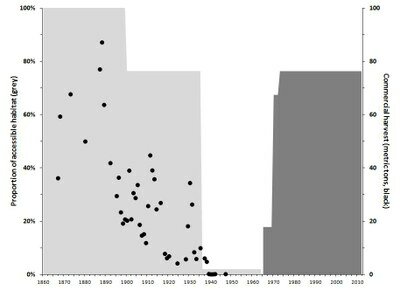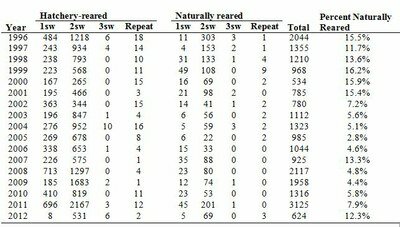Abundance and Distribution
Abundance and distribution of Atlantic salmon within the range of the GOM DPS have drastically declined from the historical levels of the 1800s (Fay et al. 2006). Data sets tracking adult abundance are not available throughout this historical time period, but observations and catch data provide important reference points to compare to current population estimates. For example, Foster and Atkins (1869) estimated that roughly 100,000 adult salmon returned to the Penobscot River prior to the 1860s before damming in the river reduced adult returns. Based on U.S. Fish Commission Reports, Baum (1997) reports commercial catches of 10,016 fish in the Penobscot in 1880 and approximately 20,000 fish per year from 1870 to 1890. He also assembles a comprehensive time series of adult sport catch data from Maine dating back to 1936 that includes rivers outside the current GOM DPS. This time series of sport catch data in Maine rivers shows a few hundred fish (maximum 480) per year were caught from 1936 to 1976, with more in the 1980s (maximum: 1,396).

Figure 3. Estimated timeline of habitat loss (grey shaded area) and commercial harvest (black dots) of Atlantic salmon from the Penobscot River, Maine (18602012). Credit: NOAA
Abundance and distribution of Atlantic salmon have been heavily impacted by dam construction. Use of dams in the Penobscot River basin goes back several hundred years; however, channel-spanning dams were possible beginning only in the 1820s and 1830s creating substantial passage barriers for Atlantic salmon and other sea-run fish. With increasing numbers of modern channel-spanning dams, the estimated amount of accessible habitat decreased and the river became virtually inaccessible in the 1930s (figure 6). Passage improved with the construction of numerous fishways starting in the mid 1960s (darker grey shaded area) although passage via fishways is not 100 percent effective, and mortality, altered migration, and significant delays can still occur. Commercial fishery reports go back to the mid-1800s and peaked at 87 metric tons in 1888. In 1948, the commercial harvest was approximately 0.2 metric tons, and the fishery was officially closed.
Contemporary abundance estimates (USASAC 2013) are informative in considering the current recovery status of the GOM DPS. After a period of population growth in the 1970s, adult returns of salmon in the GOM DPS steadily declined through the 1990s, leveling at around 1,000 adult returns since 2000 (figure 7).

Figure 4. Total estimated GOM DPS adult returns from 1967 to 2012 (USASAC 2013).
Recently biologists have started to separate hatchery-origin (parr and smolts) and naturally reared (wild, egg planted, fry stocked) adult returns. Hatchery-origin return rates of adults that spent two winters at sea (2SW adult) remained relatively high throughout the 1970s and early 1980s (~50 adult returns per 10K smolts), and salmon populations in the GOM DPS remained relatively stable during this same time period. Total adult return rates dropped dramatically during the 1990s and 2000s (~10 adult returns per 10K smolts), which is likely an indication of low marine survival (USASAC 2013). Adult returns to the GOM DPS have been very low for many years and remain extremely low in terms of naturally reared adult spawners.
A recovered GOM DPS will ultimately require wild adult spawners because they represent the self-sustaining portion of the population that will require minimal ongoing management and investment of resources. Until that time, naturally reared offspring are central to the recovery goal. The term ‘‘naturally reared’’ includes fish originating from wild spawners and hatchery egg or fry (USASAC 2013). Hatchery fry are included because they are not marked and cannot be visually distinguished from fish produced from natural spawning (termed “wild”). The term “hatchery-reared” includes fish that are stocked as either parr or smolts from CBNFH or GLNFH, and although stocking these life stages is important in preventing extinction and increasing adult escapement, they cannot be counted toward recovery goals. As illustrated in table 1, of the 3,125 adult returns to the Penobscot River in 2011, 2,878 (92 percent) were hatchery-reared, and only the remaining 247 (8 percent) were naturally reared.
Declines in the percent of naturally reared salmon are evident in the Penobscot River (table 1). Hatchery-reared adult returns appear to be stable, which is likely due to the effects of hatchery supplementation. Hatchery supplementation over this time period has been relatively constant at approximately 550,000 smolts per year in the Penobscot (USASAC 2013).
Table 1. Adult returns to the Penobscot River from 1996 to 2012, by origin (hatchery-reared and naturally reared) and age (1SW = one winter at sea; 2SW = two winters at sea; 3SW = three winters at sea; and Repeat indicates the individual was a repeat spawner).

1. Stocking large numbers of smolts aimed at increasing adult returns, thus reducing demographic risks (i.e., extinction risks) to populations that would otherwise be smaller.The Federal hatcheries, Craig Brook NFH and Green Lake NFH, are the life-support system for the GOM DPS. These two hatcheries reduce short-term extinction risks to the GOM DPS. The goal of the conservation hatchery program is to maintain abundance and diversity of the GOM DPS. The three strategies used are:
2. Stocking large numbers of multiple life stages to reduce the risks of catastrophic loss. The assumption is that at least one cohort is always at sea and could be collected as broodstock in the case of a catastrophic event in fresh water (e.g., a large contaminant spill) or in a hatchery (e.g., disease outbreak).
3. Stocking large numbers of hatchery fish at the fry stage to maximize exposure to natural environmental factors throughout a majority of the life history. Increasing exposure to natural selection pressures provides some assurance of maintaining genetic fitness.
Recent adult population estimates of Atlantic salmon in the GOM DPS are lower than returns in the 1970s and 1980s (figure 7). The current percentage of fish that are naturally reared continues to be small (approximately 5 percent in recent years). The conservation hatchery program has assisted in slowing the decline and helped stabilize populations at low levels, but has not contributed to an increase in the overall abundance of salmon and has not been able to halt the decline of the naturally reared component of the GOM DPS.
NOAA and USFWS (2009) described the historical distribution of Atlantic salmon in the DPS. Their range included most of the Androscoggin River except above Rumford Falls and Snow Falls on the Little Androscoggin River; the Kennebec River except above Grand Falls on the Dead River; the Penobscot River except above Big Niagara Falls, Grand Pitch on Webster Brook, and Grand Falls on the Passadumkeag River; and all portions of the Downeast rivers. Historical distribution is estimated to have covered 45,980 square kilometers (km2), or 50 percent of the State of Maine (91,652 km2). Approximately 19,311 km2 (42 percent) of this historical habitat is thought to be occupied now (NOAA 2009). The risk of low population abundance to the GOM DPS is compounded by having a majority of the population contained within the Penobscot River (table 2).
Table 2. Adult returns to the small coastal rivers, the Penobscot River, the Kennebec River, and the Androscoggin River from 2001 to 2012 (USASAC 2013).

Document Actions



